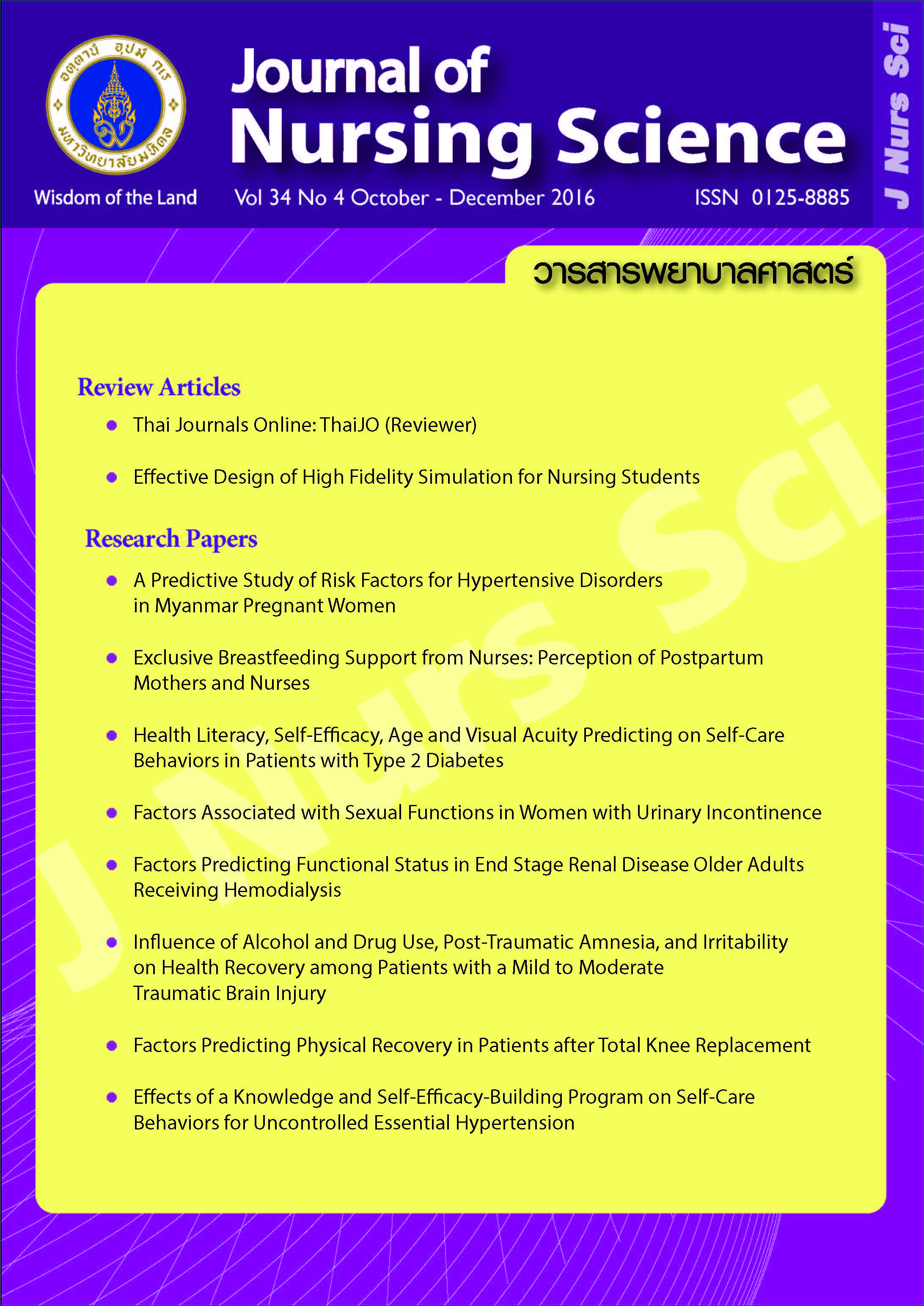Health Literacy, Self-Efficacy, Age and Visual Acuity Predicting on Self-Care Behaviors in Patients with Type 2 Diabetes
Main Article Content
Abstract
Abstract
Purpose: To examine the prediction of health literacy, self-efficacy, age and visual acuity on self-care behaviors of patients with type 2 diabetes.
Design: A correlation predictive design.
Methods: The sample included 95 patients with type 2 diabetes in medical out-patient department at tertiary hospital who are age over 18 years old, good oriented, be able to communicate, be able to read Thai language and calculation, had latest HbA1C result within 6 months. Instruments were divided into 4 parts including demographic data, health literacy, self-efficacy and self-care behaviors. Data were analyzed by using descriptive statistics, and multiple regression analysis.
Main findings: The average age of samples was 58.34 (SD = 11.378). Majority of samples had normal visual acuity (86%). The mean functional health scores of samples were in high level (X = 13.23, SD = 4.21). However, the mean of self-efficacy literacy and self-care behaviors scores of those samples was only in moderate level (X = 63.62, SD = 9.95 and X = 67.88, SD = 12.73 respectively). Only health literacy and self-efficacy had statistically significant positive correlations with self-care behaviors (r = .68, p < .05 and r = .42, p < .05 respectively and also together predicted self-care behaviors (R2 = .55, F(4, 90) = 27.37, p < .05).
Conclusion and recommendations: Healthcare providers should pay attention to improve both health literacy and self-efficacy levels of diabetes type 2 people aims to promote self-care behaviors and also leads to achieve diabetes control.
ความแตกฉานด้านสุขภาพ การรับรู้สมรรถนะแห่งตนในการดูแลตนเองอายุ และความสามารถในการมองเห็น ในการทำนายพฤติกรรมในการดูแลตนเองในผู้ป่วยเบาหวานชนิดที่ 2
บทคัดย่อ
วัตถุประสงค์: เพื่อศึกษาความแตกฉานด้านสุขภาพ การรับรู้สมรรถนะแห่งตนในการดูแลตนเอง อายุ และความสามารถในการมองเห็น ในการทำนายพฤติกรรมการดูแลตนเองในผู้ป่วยเบาหวานชนิดที่ 2
รูปแบบการวิจัย: การวิจัยหาความสัมพันธ์เชิงทำนาย
วิธีดำเนินการวิจัย: กลุ่มตัวอย่าง คือ ผู้ป่วยเบาหวานชนิดที่ 2 จำนวน 95 คน ที่เข้ารับการรักษาในแผนกตรวจโรคผู้ป่วยนอกอายุรศาสตร์ โรงพยาบาลระดับตติยภูมิ มีอายุ 18 ปีขึ้นไป มีการรับรู้ดี สามารถสื่อสาร อ่านภาษาไทย และคำนวณได้มีผลค่าระดับน้ำตาลเฉลี่ยสะสม (HbA1C) ครั้งล่าสุดไม่เกิน 6 เดือน เครื่องมือในการเก็บข้อมูลแบ่งเป็น 4 ส่วน คือ ข้อมูลส่วนบุคคล ความแตกฉานด้านสุขภาพ การรับรู้สมรรถนะแห่งตนในการดูแลตนเอง และพฤติกรรมในการดูแลตนเอง วิเคราะห์ข้อมูลโดยใช้สถิติเชิงพรรณนา และการวิเคราะห์ถดถอยแบบพหุคูณ
ผลการวิจัย: กลุ่มตัวอย่างอายุเฉลี่ย 58.34 (SD = 11.38) กลุ่มตัวอย่างส่วนใหญ่มีความสามารถในการมองเห็นอยู่ในเกณฑ์ปกติ ร้อยละ 86.1 มีค่าเฉลี่ยคะแนนของความแตกฉานทางสุขภาพขั้นพื้นฐานอยู่ในระดับสูง (X = 13.23, SD = 4.21) ส่วนการรับรู้สมรรถนะแห่งตนและพฤติกรรมการดูแลตนเองอยู่ในระดับปานกลาง (X = 63.62, SD = 9.95 และ X = 67.88, SD = 12.72 ตามลำดับ) มีเพียงระดับความแตกฉานทางสุขภาพ และการรับรู้สมรรถนะแห่งตนที่มีความสัมพันธ์ทางบวกกับพฤติกรรมในการดูแลตนเอง (r = .68, p < .05 และ r = .42, p < .05 ตามลำดับ) และทั้งสองปัจจัยสามารถร่วมกันทำนายพฤติกรรมการดูแลตนเองได้อย่างมีนัยสำคัญทางสถิติ (R2 = .55, F(4, 90) = 27.37, p < .05)
สรุปและข้อเสนอแนะ: ทีมบุคลากรทางสุขภาพควรให้ความสำคัญในการพัฒนาระดับความแตกฉานทางสุขภาพ และสมรรถนะแห่งตนในผู้ป่วยเบาหวานชนิดที่ 2 เพื่อส่งเสริมพฤติกรรมการดูแล และบรรลุเป้าหมายการควบคุมโรคเบาหวานต่อไป
คำสำคัญ: ความแตกฉานด้านสุขภาพ การรับรู้สมรรถนะแห่งตน ความสามารถในการมองเห็น พฤติกรรมการดูแลตนเอง ผู้ป่วยเบาหวานชนิดที่ 2
Article Details
Copyright Notice: Nursing Science Journal of Thailand has exclusive rights to publish and distribute the manuscript and all contents therein. Without the journal’s permission, the dissemination of the manuscript in another journal or online, and the reproduction of the manuscript for non-educational purpose are prohibited.

Disclaimer: The opinion expressed and figures provided in this journal, NSJT, are the sole responsibility of the authors. The editorial board bears no responsibility in this regard.

